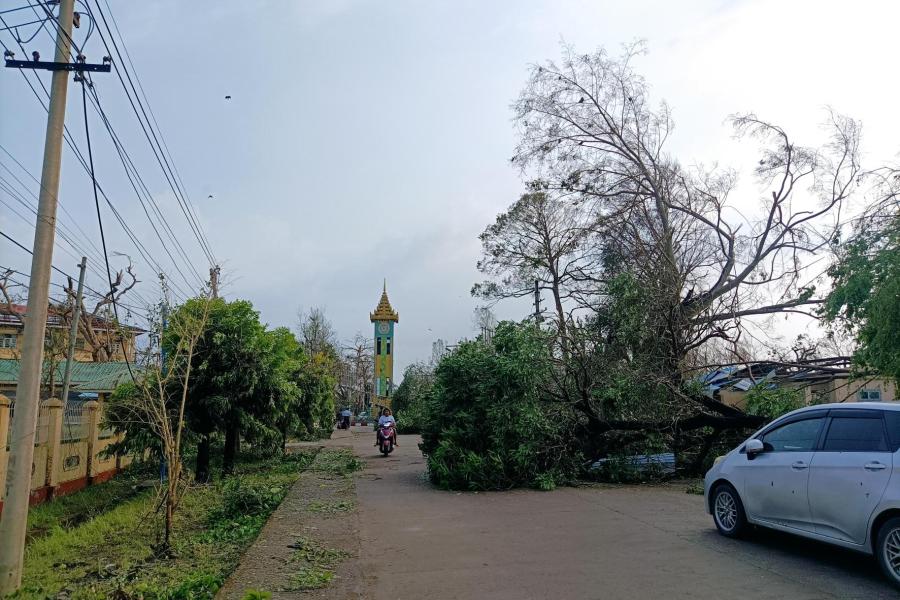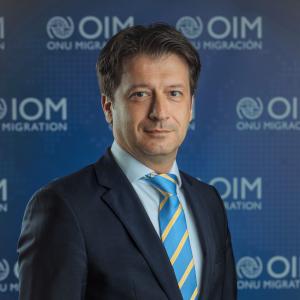IOM Mobilizes Response for Communities Devastated by Cyclone Mocha
၂၀၂၃ ခုနှစ် မေလ ၂၂ ရက်။

Geneva / Yangon – Extremely severe Cyclone Mocha, which made landfall in Rakhine State of Myanmar, near its capital Sittwe, on Sunday, 14 May, has left a trail of destruction in both Rakhine state and the Northwest of Myanmar, encompassing Chin, Magway and Sagaing states. Approaching the coast with windspeeds of up to 250km per hour, the cyclone resulted in severe damage to buildings, infrastructure and the environment.
Information on the impact of the cyclone initially emerged slowly, as phone lines and internet connectivity in Rakhine were badly affected. The damage in Sittwe and surrounding low-lying areas has been severe, with most buildings affected and many houses completely destroyed. Damage in Rathedaung township is also severe. Telecommunications problems persist, however, field observations indicate damage and loss of life in several other townships as well, including Buthidaung, Kyauktaw, Maungdaw, Minbya, Mrauk-U, Pauktaw and Ponnagyun.
Information on the impact in Northwest Myanmar – already one of the areas most affected by conflict and political turmoil – is emerging slowly, but early reports suggest that several areas of Chin, Magway and Sagaing, have suffered damage due to flooding and strong winds, while flash updates from the Office for the Coordination of Humanitarian Aid (OCHA) indicate that almost 5.4 million people are estimated to have been in the path of the cyclone.
While many people had evacuated from areas expected to be most affected in Rakhine and other locations, evacuation centres were also hit by the storm, causing damage and partial collapse of buildings. Initial observations suggests that internally displaced persons (IDP) camps, in particular those close to the coast and riverbeds, were severely hit, greatly damaged and/or destroyed. Access to clean water and food is very limited and remains a top need for affected populations, while other priority needs include shelter, as well as non-food items such as blankets and solar lamps, and health assistance.
“It is important to remember that the areas affected by the cyclone were already in dire humanitarian need. There are more than 1.2 million IDPs in Rakhine and the Northwest alone, and 17.6 million people were already in need of assistance nationwide before this disaster,” said IOM Chief of Mission, Dragan Aleksoski. “The impact of Cyclone Mocha will further worsen the situation of people already in very difficult circumstances and therefore immediate access to the affected people for delivery of humanitarian aid is paramount.”
IOM has been present in Myanmar since 2006 and was instrumental in the response to Cyclone Nargis in 2008. IOM’s support to mobile communities in Rakhine is significant, and the Organization has been providing shelter and non-food items support, including shelter construction, site improvements, including WASH facilities, and distribution of critical items to IDP populations, such as cooking fuel sticks, tarpaulins, as well as multi-purpose cash, in coordination with shelter and camp management partners.
IOM health teams have also been providing essential health services to those most in need, in coordination with local and community-based actors, including community-based health workers and village health committees. Current support includes essential maternal, newborn and child health care services, nutrition promotion, clinical referrals, as well as direct assistance through mobile health teams, including immunization services and TB case management.
With over 240 staff across Myanmar, and direct presence in Sittwe, Maungdaw, Buthidaung, and Pauktaw, IOM is mobilizing teams to facilitate rapid support of mobile and cyclone-affected communities across Rakhine.
Surge support staff have been mobilized, and IOM teams on the ground in Rakhine are currently gauging the full impact of the cyclone, in coordination with humanitarian partners. With markets across the state severely affected, IOM is preparing to send relief items from Yangon to support immediate assistance to impacted families.
IOM health teams are also on stand-by to provide mobile health services to populations in need. Transfer of resources from other IOM missions in the region, is also being explored in light of the vast emerging needs in cyclone-affected areas, while coordination with all relevant actors to ensure critical and life-saving assistance reaches the most vulnerable is also being undertaken in line with humanitarian principles.
"We have maintained a consistent presence in Myanmar through multiple crises and remain committed to stay and deliver in support of all the people of Myanmar,” said Aleksoski.


၎င်း၏လက်ရှိရာထူးမစမီ၊ ဒရာဂန် သည် အရှေ့တောင်ဥရောပ၊ အရှေ့ဥရောပ နှင့် ဗဟိုအာရှ အတွက် ဗီယင်နာ ရှိ IOM ဒေသဆိုင်ရာရုံး တွင် ကုလသမဂ္ဂမစ်ရှင် နှင့် အခြားသော နိုင်ငံတကာ အဖွဲ့အစည်းများအတွက် အကြီးတန်းဒေသဆိုင်ရာ အရေးပေါ်နှင့် အကျပ်အတည်းနောက်ပိုင်း အထူးကျွမ်းကျင်သူ (Senior Regional Emergency and Post-Crisis Specialist) အဖြစ် တာဝန်ထမ်းဆောင်ခဲ့သည်။ ၎င်းထဲတွင် ဒေသတွင်းနိုင်ငံများတွင် IOM ၏ အရေးပေါ်နှင့် အကျပ်အတည်းလွန်လှုပ်ရှားမှုများနှင့် ဝန်ဆောင်မှုများ ဖွံ့ဖြိုးတိုးတက်ရေးနှင့် အကောင်အထည်ဖော်မှုများအတွက် နည်းပညာဆိုင်ရာ ပံ့ပိုးကူညီမှုပေးမှုများအား တာဝန်ယူခဲ့သည်။ ယင်းမတိုင်မီတွင် တာဂျစ်ကစ္စတန် ရှိ ရွှေ့ပြောင်းသွားလာနေထိုင်ခြင်းဆိုင်ရာ နိုင်ငံတကာအဖွဲ့အစည်း (အိုင်အိုအမ်) ၏ ဌာနေကိုယ်စားလှယ် အဖြစ်လည်း တာဝန်ထမ်းဆောင်ခဲ့သည်။ ဒရာဂန် သည် ၎င်း၏ ပရော်ဖက်ရှင်နယ်အသက်မွေးဝမ်းကြောင်းအား အိုင်အိုင်အမ် ဖြင့် မြောက်မက်ဆီဒိုးနီးယားမှ ကိုဆိုဗိုဒုက္ခသည်များကို လူသားချင်းစာနာထောက်ထားမှုဆိုင်ရာ ကယ်ထုတ်ရေးအစီအစဉ် အား ၁၉၉၉ တွင် လုပ်ဆောင်ခြင်းဖြင့် စတင်ခဲ့ပြီး၊ ထို့နောက် ထိုင်း၊ အရှေ့တီမော၊ နမီးဘီးယား၊ ပါကစ္စတန်နှင့် ခရိုအေးရှားတို့အပါအဝင် နိုင်ငံပေါင်းစုံတွင် အလုပ်လုပ်ကိုင်ခဲ့သည်။
ဒရာဂန် သည် Skopje ရှိ တက္ကသိုလ်မှ နိုင်ငံရေးသိပ္ပံ မဟာဘွဲ့ နှင့် Maastricht တက္ကသိုလ်မှ ရွှေ့ပြောင်းသွားလာနေထိုင်ခြင်းအားလေ့လာခြင်း (Migration Studies) အတွက် အထူးပြုသင်တန်း ဒီပလိုမာ ရရှိထားသူဖြစ်သည်။




